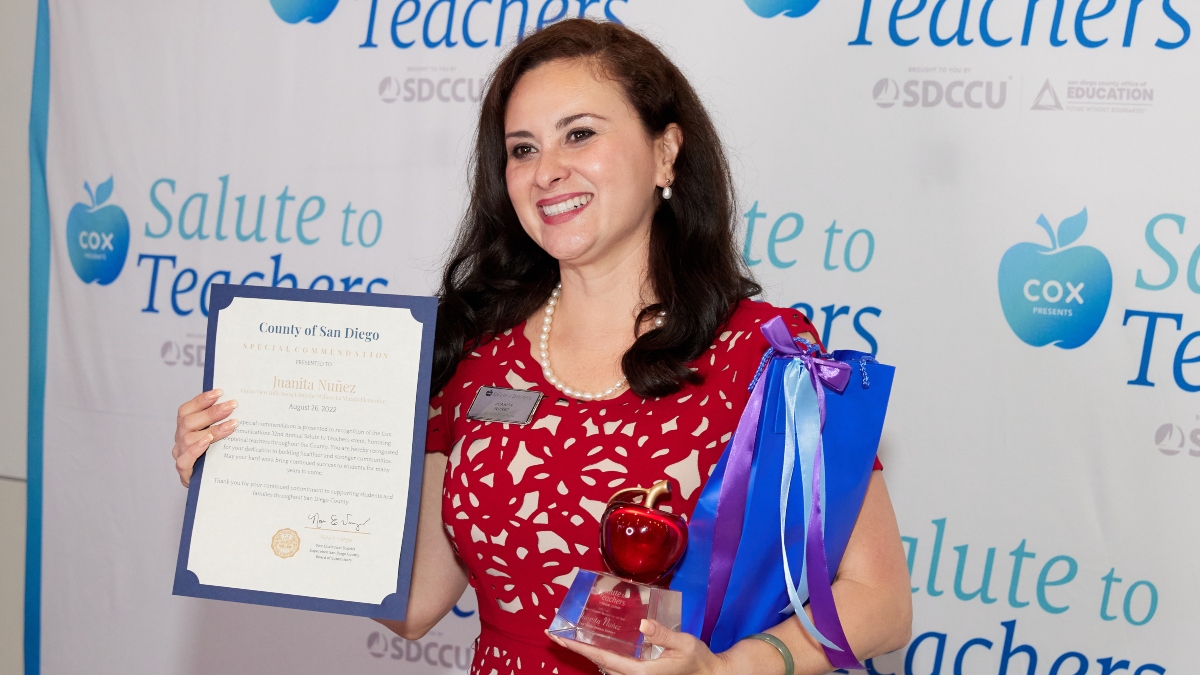 |
| Photo by Terri Rippee. |
Juanita Nuñez’s (’01) road to becoming one of San Diego County’s best teachers started with 524 miles of sun-scorched asphalt.
The combination of highways spanning the California farming communities of Salinas and Calexico defined much of the San Diego State University alumna’s childhood. Nuñez — who was born near the journey’s midway point in the town of Camarillo — was constantly on the move between north and south, and from one classroom to the next.
As she and her four siblings mastered reading, writing and arithmetic in public school, their migrant farmworker parents worked the fields, picking lettuce, strawberries, cantaloupes and other staples of the state’s agricultural bounty. But home was always temporary for the Nuñez family.
Only the road was constant.
“A lot of people don't really understand what a migrant student is,” said Nuñez, whose parents also worked in Arizona and New Mexico. “We would travel to Salinas and do three months in public school. My parents would say, ‘OK the crops are done.’ Then we would pack everything in boxes, drive everything back to the Imperial Valley and we’d start over at a new school.
“Of course, by then, school had already started. So we were always feeling left out.”
It’s an experience that forged a bold and compassionate educator — one the San Diego County Office of Education saw fit to name one of its five 2022-2023 Teachers of the Year in late August. She will be honored during “Cox Presents: Salute to Teachers,” airing throughout October and will be in the running for the California Teacher of the Year award.
Radiating Love and Acceptance
Fewer than two miles separate the U.S.-Mexico border from the center of San Ysidro, a community where Nuñez, a bilingual educator, teaches science, technology, engineering and mathematics (STEM) and physical education in five different elementary schools.
The San Ysidro School District serves a border community where young people face daunting statistics. More than 80 percent of its students are English learners and as many as one-third have experienced homelessness.
“Having that background as a migrant student, my heart radiates pure love and acceptance for my students,” Nuñez said. “I say, ‘You know what, maybe you don't know the English language, but I'm here for you.’ I know that with the right teachers and the right environment, these students can succeed.”
In her unique position in the district, Nuñez works with about 300 students across her five schools. This year, she moved from teaching fourth through sixth grades to teaching transitional kindergarten as well as a new class that brings STEM subjects to children in special education.
“I love my job,” she said. “And STEM is the future — we're creating future engineers, future doctors.”
Finding Opportunity at SDSU
Traversing another stretch of highway — the 109 miles of wind-swept mountain passes between Calexico and the San Diego campus — helped give Nuñez the tools she needed to succeed as a teacher.
All five Nuñez siblings left the Imperial Valley to attend SDSU. And all five eventually became educators, including the eldest, Guillermina Gina Núñez-Mchiri, who was named dean of SDSU Imperial Valley earlier this year.
“I am so proud of my sister Juanita’s accomplishments as San Diego County's Teacher of the Year,” Núñez-Mchiri said. “She represents our U.S.-Mexico borderlands with excellence in STEM and bilingual education.”
Added Juanita: "My sister Gina paved the way. My parents were old school, so it was very hard for them to let her go away to study. But they were influenced by the (U.S. Department of Education’s) Migrant Education Program which emphasized the value of an education. I'm very grateful because that influenced the path for this generation to change.”
As a student in SDSU’s liberal studies program, Nuñez thrived under the mentorship of professor emeritus Alberto Ochoa and professor Cristina Alfaro.
It was Alfaro, now SDSU’s associate vice president for international affairs, who convinced her to earn her bilingual teaching credential through the International Teacher Education Program she directed in Queretaro, Mexico. Nuñez called the year-long experience “life-changing,” teaching in both Indigenous and public school settings.
“I recall Juanita as one of our most outstanding bilingual teacher candidates,” Alfaro said. “She graduated from the program with the essential knowledge, global critical consciousness and skills to effectively teach in a vibrant transborder region. I am extremely proud of the powerful impact she has made in her students’ and their families’ lives.”
Added Nuñez: "I'm very grateful to San Diego State. I want to say thank you to all the people that believed in us."
